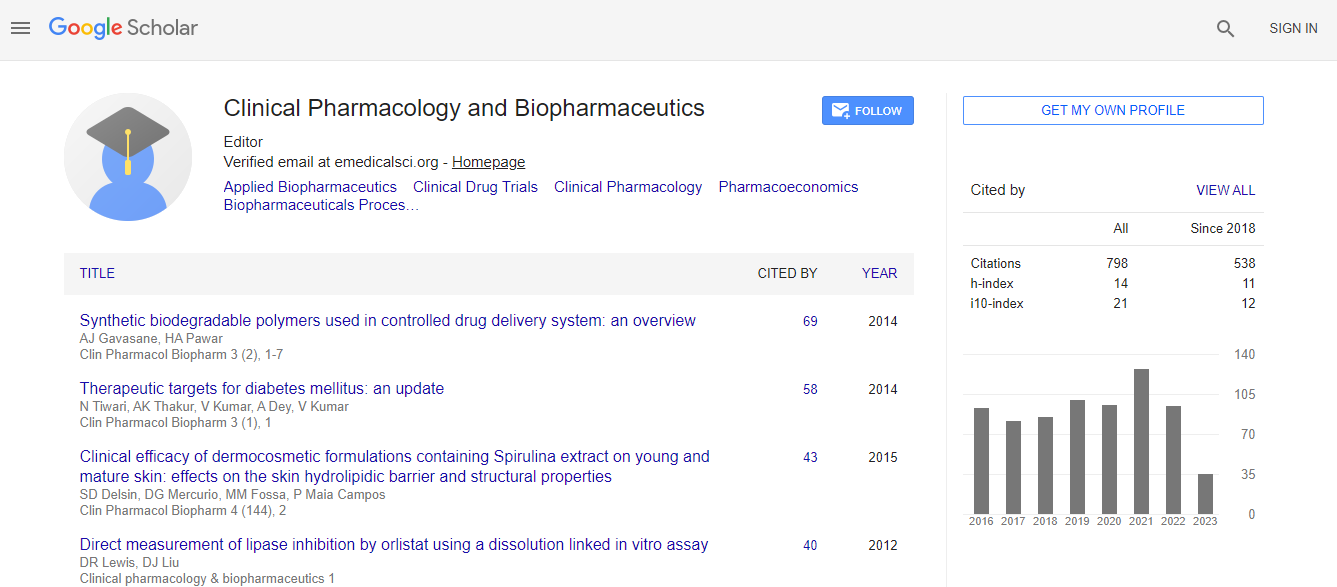Our Group organises 3000+ Global Conferenceseries Events every year across USA, Europe & Asia with support from 1000 more scientific Societies and Publishes 700+ Open Access Journals which contains over 50000 eminent personalities, reputed scientists as editorial board members.
Open Access Journals gaining more Readers and Citations
700 Journals and 15,000,000 Readers Each Journal is getting 25,000+ Readers
Google Scholar citation report
Citations : 1089
Clinical Pharmacology & Biopharmaceutics received 1089 citations as per Google Scholar report
Clinical Pharmacology & Biopharmaceutics peer review process verified at publons
Indexed In
- CAS Source Index (CASSI)
- Index Copernicus
- Google Scholar
- Sherpa Romeo
- Genamics JournalSeek
- RefSeek
- Hamdard University
- EBSCO A-Z
- OCLC- WorldCat
- Publons
- Euro Pub
- ICMJE
Useful Links
Recommended Journals
Related Subjects
Share This Page
Prophylactic Ozone Administration Reduces Renal Ischemia-Reperfusion Injury in The Rat
International Conference and Expo on Biopharmaceutics
Oznur Kal, Ishak Akillioglu, Ali Kal, Esin Celik, Mustafa Yilmaz and Ozkan Onal
Baskent University Medical Faculty Department of Nephrology, Konya Selcuk University Medical Faculty Department of Anesthesiology and Reanimation Baskent University Medical Faculty Department of Pediatric Surgery, Konya Baskent University Medical
Posters-Accepted Abstracts: Clin Pharmacol Biopharm
Abstract
Introduction: Ischemia/reperfusion injury, which is commonly seen in the field of renal surgery or transplantation, is a major cause of acute renal failure. Various beneficial effects of ozone have been shown. Among these, its triggering the formation of new capillary, increasing the number of defensive cells in immune response, and cellular energy release, and anti-oxidant efficacy may be mentioned. The objective of this study was to examine the role of the Ozone oxidative preconditioning in modulating inflammation and apoptosis after renal ischemia/reperfusion injury. Material and Method: After the approval of Selcuk University animal ethics committee, 27 Wistar rats were randomized into four groups. Sham-operated control group (n:6) was administered SF intraperitoneally seven days without creating ischemia reperfusion injury and at eight day the rats were sacrified. Ozone group (n:7) was administered 1 mg/kg ozone intraperitoneally for seven days without creating ischemia reperfusion injury and at eight day the rats were sacrified. Ischemia Reperfusion (IR) group (I/R) (n:7) were subjected to renal ischemia for 1 hour by left renal artery and vein were occluded with a nontraumatic clamp and then reperfusion for two hours. In Ozone + IR group, 1 mg/kg ozone was administered intraperitoneally for seven days before the ischemia/reperfusion procedure and at eight day the ischemia reperfusion injury was created (as in group 2) and rats were sacrified at the same day. Subsequently, occlusion was terminated after 2nd hour of reperfusion, rats were anesthetized with 80 mg/kg ketamin and their intracardiac blood was drawn completely and they were sacrificed. Renal tissue samples were sent to laboratory for superoxide dismutase (SOD), glutation peroxidase (GSH-Px), malondyaldehide (MDA) and blood samples were sent for total oxidant score (TOS) and total antioxidant capacity (TAC) analysis. The degree of renal injury was evaluated by structural changes in proximal tubules (tubular atrophy, loss of tubular brush border, vacuolization, tubular dilatation, cast formation), mononuclear cells (MNCs) infiltration, interstitial structural changes, renal corpuscle morphology, and necrotic and apoptotic cells. Data were evaluated statistically by Kruskal Wallis test. Results: In ischemia-reperfusion group, the degree of renal injury was found highest and statically significantly compared to the other groups (p<0.05). In the group administered ozone before ischemia reperfusion procedure, renal injury was found to be decreased in comparison to ischemia reperfusion group (p<0.05). In sham control group administered only sf without creating renal ischemia/reperfusion injury, renal injury score was the lowest compared to the other groups (p<0.05). The difference according to the antioxidant parameters SOD, GPX TAC values were found to be increased in ozone group and lowest in IR group (p<0.05). The difference according to the oxidant parameters MDA and TOS were found to be highest in IR group and decreased in ozone group (p<0.05) . Discussion: Ischemic tissue reperfusion aggravates acute ischemic injury via the formation of reactive oxygen and nitrogen components. In the present study, ozone administration had an effect improving renal I/R injury. Ozone preconditioning was ameliorated ischemic reperfusion injury and renal ischemia reperfusion injury score was decreased significantly. In the present study, ozone therapy prevented from ischemia reperfusion injury. Further studies are required to explain the mechanisms mediating the protective effect of ozone on renal IR injury.Biography
Email: drozkanonal@selcuk.edu.tr

 Spanish
Spanish  Chinese
Chinese  Russian
Russian  German
German  French
French  Japanese
Japanese  Portuguese
Portuguese  Hindi
Hindi 
